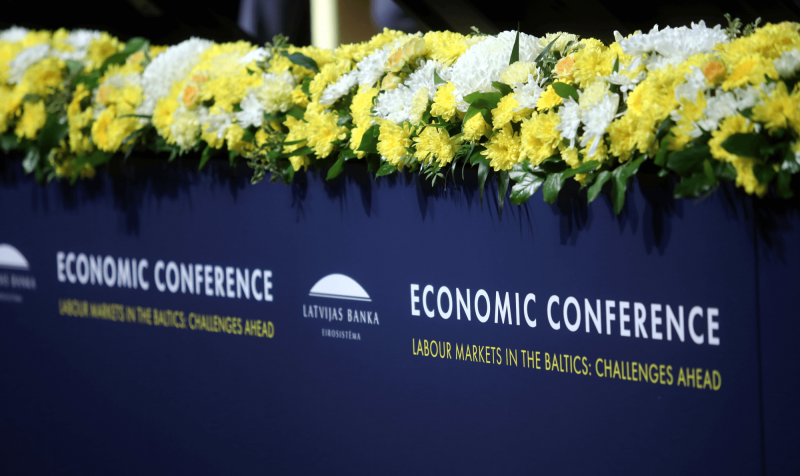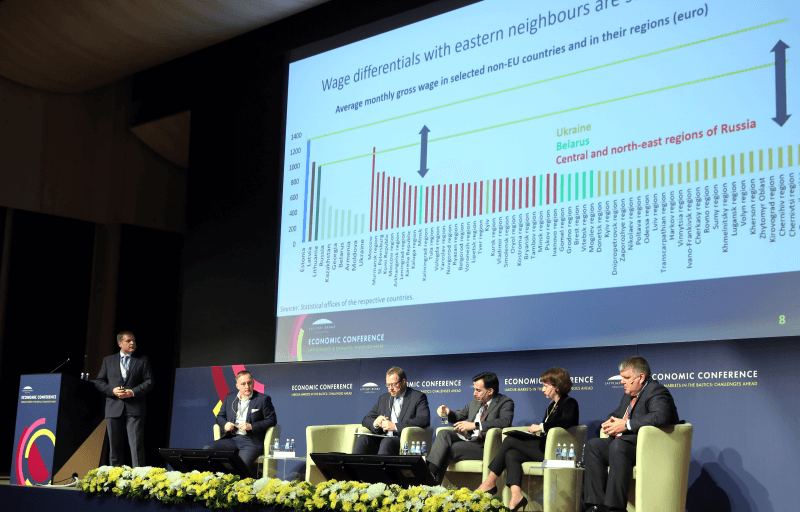Economic Conference "Labour Markets in the Baltics: Challenges Ahead"

Latvijas Bankas tautsaimniecības konference 2019

Latvijas Bankas tautsaimniecības konference 2019

Latvijas Bankas tautsaimniecības konference 2019

Latvijas Bankas tautsaimniecības konference 2019

Latvijas Bankas tautsaimniecības konference 2019

Latvijas Bankas tautsaimniecības konference 2019

Latvijas Bankas tautsaimniecības konference 2019

Latvijas Bankas tautsaimniecības konference 2019

Latvijas Bankas tautsaimniecības konference 2019

Latvijas Bankas tautsaimniecības konference 2019

Latvijas Banka's annual economic conference on 2 October 2019 was dedicated to the future challenges of the labour markets in the Baltics. At the conference, economists and business representatives analysed the ongoing changes in the labour markets of the Baltic countries caused by the demographic and technological developments as well as the required policy responses.
Conference materials, including the expert presentations, the video, photos as well as the commentaries of Latvijas Banka's economists on the labour market challenges and the discussion paper on the labour reserves in the Baltic countries prepared by Oļegs Krasnopjorovs, Latvijas Banka's economist, are available at www.macroeconomics.lv.
-
Discussion Paper
Discussion Paper "Anatomy of labour reserves in the Baltic countries: a snapshot 15 years after the EU accession" investigates internal and external labour reserves in Latvia, Estonia and Lithuania. We find considerable internal labour reserves in the form of still high natural rate of unemployment and in hidden unemployment as many economically inactive people are available for work but are not actively engaged in job seeking.
-
Articles of Latvijas Banka's economists
Krista Kalnbērziņa, What do demographic challenges mean to the Baltic labour market?
Ludmila Fadejeva, Labour Market Reforms in the European Union: an Overview
Oļegs Krasnopjorovs, Why are Baltic labour reserves far from exhausted?
Vents Vīksna, Kristofers Pone, Can we compete with artificial intelligence on the labour market?
-
Presentations
-
Photos
-
Video on Baltic labour market, automation and AI
Businesses about situation in Baltic labour markets
Is automation the new black?
Automation examples in Baltic countries
Will robots replace us?
What artificial intelligence solutions are developed in the Baltics?
Various artificial intelligence solutions are developed in the Baltics. Watch the video on our own smart technologies already used by Latvian, Lithuanian and Estonian businesses. The voice-over of this video was created by a robot – a tool of the language technology platform hugo.lv.
-
Video summary of the conference
-
Full video of the conference
Part I
Part II
-
Overview of Latvijas Banka's conference
On 2 October 2019, Latvijas Banka held its 16th annual conference on the future opportunities and challenges for the labour market. The subject is directly related to the primary task of the national central bank: maintaining stable inflation "close to, but below, 2%", with the inflation rates affected by the wage dynamics and consumption as well as the business cycle, demographic trends and other long-term labour market factors.
- The questions raised were rather practical: What to expect in the future? What is the most sensible way to proceed for policy-makers, businesses and people facing labour market challenges? Does automation give us an opportunity to escape the middle income trap? Does it enable us to increase the productivity and income quickly and with the broadest possible coverage?
- The audience was more colourful than at a purely academic forum: economists, policy-makers, lifelong learning advocates as well as prominent practitioners – business representatives, HR managers and start-ups.
Over the last few years, all three Baltic countries have seen their labour markets warming up, with businesses experiencing labour shortages and people – low unemployment and rising wages. These developments were largely caused both by structural megatrends, such as population ageing, low birth rates and technological opportunities, and by the economic cycle. The region's economies have been on an upward swing for quite some time now. At the same time, their labour markets have suffered from labour demand and supply mismatches.
What can be done? Discussion paper by Oļegs Krasnopjorovs, Economist of Latvijas Banka, focusses on the local labour reserves which are far from exhausted, with the unemployed amounting to more than 25 thousand, 55 thousand and 85 thousand in Estonia, Latvia and Lithuania respectively.
- Importing labour seems a simple solution. For instance, the current wage gap between the Baltics and Ukraine is similar to that observed between the Baltics and the UK 15 years ago when the locals migrated to the UK.
- Economists of Latvijas Banka recommend activating the local labour force in a more forward-looking way: this will be a costly but smart investment and will allow avoiding life-long social benefit payments. The largest labour reserves in the Baltics fall into two groups: young people (lack of dual vocational education with in-company training) and middle-aged men (age 45–65; out-of-date education, weak computer skills and poor health).
- Director of the State Employment Agency of Latvia mentioned the state support programme designed to improve the geographic mobility of job-seekers by encouraging the unemployed to move from locations offering no jobs to locations with job opportunities. The reality is harsh: well-paid jobs will not chase you! In Latvia, such jobs can be found in Riga and other larger cities.
On an overall positive note and without defeatism, it was concluded: to ensure that the Baltic countries keep up with time and their people continue earning higher wages, the introduction of technologies is unavoidable. All economies do it, and it is also a precondition for the Baltic countries if they wish to avoid becoming low-income economies in the future.
- The transition will not take place on its own, and we should be prepared to invest in it.
- We will need to pay much attention to the social security network. We should consider whether the costs should be covered by taxing the income of technology creators, i.e. the businesses earning their income, e.g. by making redundant the drivers, etc.
Are the Baltic countries prepared? The work has begun but much more remains to be done: in terms of the number of robots relative to the number of workers, we are lagging well behind our Nordic neighbours which were among the first economies suffering under the pressure of China's low wages. Obstacles?
- Baltic businesses are small and do not have the capacity to invest in automation to overcome the difficulties associated with labour shortages; merging could be one solution.
- The wage levels still allow businesses to postpone automation but – more likely – these businesses simply lack information on the available technologies. In this regard, some help could come from government programmes such as the Danish programme providing financial and information support for certain businesses implementing automation projects.
Everyone – both businesses and people – should be involved in the transition to the new technologies.
The fear that automation will take our jobs has been around for more than 100 years. Nevertheless, employment has increased during this period. Over the last three decades, the number of jobs in the production sector has declined due to automation, while that in the services sector has almost doubled, with the share of highly qualified workers increasing. While automation does change the labour market, it also gives workers an opportunity to make their work easier and more productive and to earn higher wages, provided that they are prepared to continue learning and improve their social skills.Business representatives pointed out that businesses themselves need to be more involved in digitalisation and automation and they should pay attention to what their competitors do. Businesses introducing new technologies at an early stage have benefited from automation and so have their workers: with the monotonous and hard work done by a robot, the worker can acquire new machine-based skills; as a result, wages rise and the quality improves. One drawback in this regard is the fact that too much emphasis on specific machines comes with a loss of flexibility.
Economists pointed out: to achieve income convergence with wealthier economies, the Baltic businesses should now focus on investing in knowledge as they have already accumulated notable physical capital.
Of course, national policy plays a vital role – not only should it formulate the general concept for the technology transition, but it should also ensure investment in the vocational education and lifelong learning systems, considerably expanding them, to make the transition socially and otherwise smoother (at the moment, the level of computer skills is still low among the workers performing mechanical, manual tasks subject to high "risk" of automation). Moreover, business representatives reminded the government that the economies that are better coping with the economic cycle fluctuations are able to achieve higher living standards. Macroeconomists of the central bank reiterated this view by pointing to the lasting importance of an anti-cyclical policy, i.e. the importance of making savings during the periods of growth so that the economy could be stimulated in times of crisis.
Textual error
«… …»



